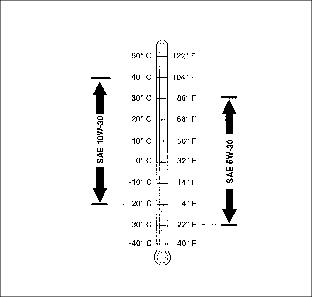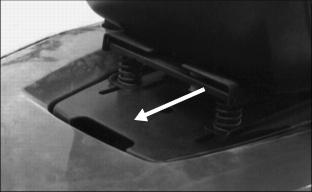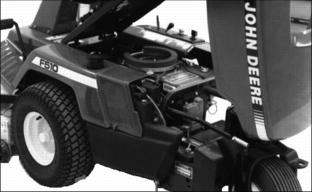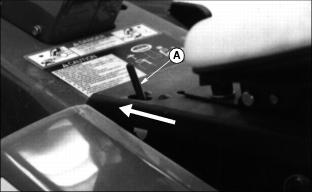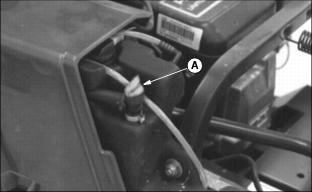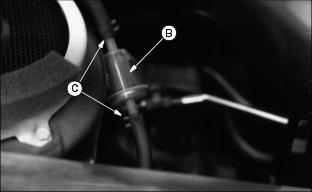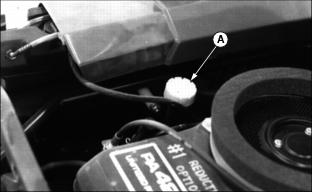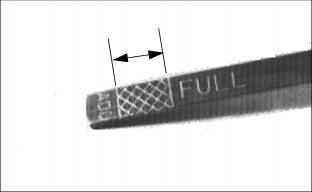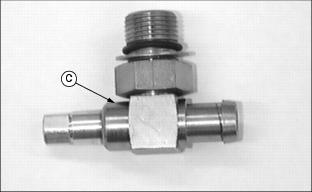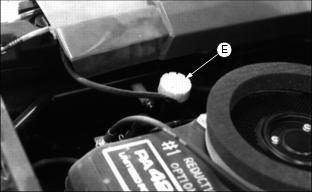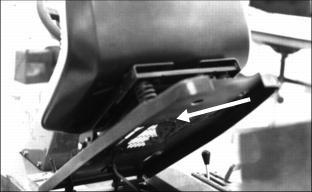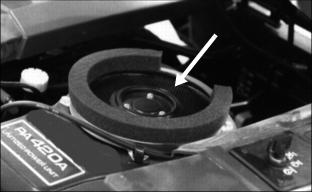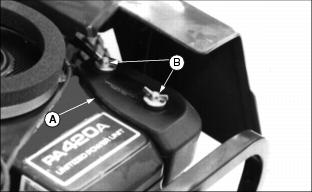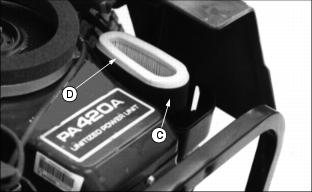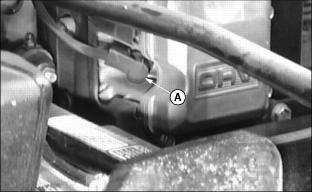Introduction
Product Identification
Safety
Operating
Replacement Parts
Service Intervals
Service Lubrication
Service Engine
Engine Warranty Maintenance Statement
Checking Engine/Transmission Oil Level
Changing Engine/Transmission Oil And Filter
Checking And Cleaning Precleaner And Air Cleaner Element
Service Transmission
Service Steering & Brakes
Service Mower
Service Electrical
Service Miscellaneous
Troubleshooting
Storage
Assembly
Specifications
Warranty
John Deere Quality Statement
Service Record
Copyright© Deere & Company

Service Engine
Engine Warranty Maintenance Statement
Maintenance, repair, or replacement of the emission control devices and systems on this engine, which are being done at the customers expense, may be performed by any nonroad engine repair establishment or individual. Warranty repairs must be performed by an authorized John Deere dealer.
Adjusting Carburetor
NOTE: Carburetor is calibrated by the engine manufacturer and should not require any adjustments.
NOTE: If engine is operated at altitudes above 1829 m (6,000 ft), some carburetors may require a special high altitude main jet. See your John Deere dealer.
NOTE: Possible engine surging will occur at high rpm with no load (with transmission in "N" neutral and mower blade engagement lever disengaged). This is a normal condition due to the emission control system.
If engine is hard to start or runs rough, check the troubleshooting section of this manual.
After performing the checks in the troubleshooting section and your engine is still not performing correctly, contact your John Deere dealer.
Avoid Fumes
Engine/Transmission Oil
Servicing Front Mower
To Service Front Mower:
Keep hands away from possible pinch areas. Be careful when you lower the hood or the seat. Hands could be pinched by seat or hood when you lower them. |
1. Lift seat at the cut-out hand-hold area and raise seat until it latches in the second position.
2. Lift hood to the open position.
After Service:
1. Lower hood to the closed position.
2. Lift seat slightly, then push and hold latch lever (A) forward.
3. Lower seat to the closed position.
Replacing Fuel Filter
NOTE: Change filter when fuel is low.
2. Turn fuel shut off valve (A) to the closed position shown.
4. Use pliers to open and slide clamps (C) away from filter.
5. Disconnect hoses from filter.
6. Install new filter with arrow on filter body pointing to the right.
8. Turn fuel shutoff valve to the open position.
Checking Engine/Transmission Oil Level
NOTE: The engine and the transmission have the same reservoir. Both systems are checked or changed at the same time.
1. Park the machine safely. (See Park Safely in the Safety section.)
3. Remove dipstick (A). Wipe it with a clean rag.
4. Install dipstick in tube, but do not tighten it. Let dipstick threads rest on top of tube.
NOTE: FULL mark on dipstick is below the word FULL.
5. Remove dipstick. Check oil level. Oil should be between ADD and FULL marks-not above FULL mark.
7. Install and tighten dipstick.
Changing Engine/Transmission Oil And Filter
NOTE: The engine and the transmission have the same reservoir. Both systems are checked or changed at the same time.
1. Park the machine safely. (See Park Safely in the Safety section.)
2. Adjust mower deck to the lowest cutting height.
Picture Note: Early model shown.
3. On Early Model Front Mowers: Put oil pan under drain plug (A). If you do not have a low enough oil pan, drive the Front Mower onto low blocks to raise the level of the oil drain plug. Remove drain plug.
Picture Note: New model shown.
4. On New Model Front Mowers: Attach optional plastic drain tube, available from your John Deere dealer, to the oil drain valve (B). Route drain tube to the side of front mower. Open valve and drain oil into drain pan.
NOTE: Early Models can have oil drain valve (C) installed. See your John Deere dealer.
6. While oil is draining, remove filter (D) by turning it counterclockwise.
7. Put film of oil on gasket of new filter.
8. Install filter. Turn filter until gasket contacts mounting surface. Then turn filter by hand 3/4 turn more.
9. On Early Model Front Mowers: Install and tighten drain plug. Remove drain pan.
10. On New ModeL Front Mowers: Close oil drain valve and remove plastic drain tube. Remove drain pan.
NOTE: Do not overfill. Capacities listed below indicate average oil amount removed during drainage. Full volume capacities are listed in the Specifications section.
12. Add oil through dipstick tube.
· F510: Add 2.1 L (2.2 qt) oil.
· F525: Add 2.4 L (2.5 qt) oil.
14. Run engine at half speed. Drive Front Mower down off blocks if blocked up to remove oil.
15. Drive Front Mower forward and in reverse several times for a short distance each way.
16. Check for leaks around filter and drain plug.
NOTE: FULL mark on dipstick is below the word FULL.
18. Check oil level. Oil should be between ADD and FULL on dipstick-not above FULL mark.
Cleaning Air Intake Screens
1. Stop engine. Lift seat and lock in second position.
2. Clean the screen that is part of the seat base.
Picture Note: Model F510 shown
3. Clean engine screen with a rag, brush, or compressed air.
Checking And Cleaning Precleaner And Air Cleaner Element
1. Park the machine safely. See Park Safely in the Safety section.)
3. Clean any dirt and debris from the air cleaner before removing the cover.
4. Remove cover (A) by removing wing nuts (B).
5. Inspect the foam precleaner and the element without removing.
IMPORTANT: Avoid damage! Engine damage or failure can occur from dirt in the carburetor. Take care when removing filter element to prevent dirt from entering carburetor. |
6. If precleaner is dirty, carefully remove filter element (D) and precleaner (C) from air cleaner housing.
NOTE: Do not wash paper element.
7. Remove precleaner (E) from element and wash precleaner in a solution of warm water and liquid detergent.
8. Rinse precleaner thoroughly. Squeeze out excess water in a dry cloth until precleaner is completely dry.
9. Put approximately 30 ml. (1 oz.) of cleans engine oil onto precleaner. Squeeze precleaner to distribute oil evenly. Squeeze out excess oil with a clean cloth.
10. Inspect filter element without removing it from air cleaner housing.
11. Remove and replace filter element with new element only if element is damaged or very dirty.
12. Carefully clean air cleaner housing. Prevent any dirt from falling into carburetor.
13. Install precleaner on paper element.
15. Install air cleaner cover with washers and wing nuts.
Checking Spark Plug
2. Disconnect spark plug wire (A) at rear left of engine. Remove spark plug.
3. Clean plug carefully with wire brush.
4. Inspect plug for damage (cracks, pits, etc.) or excess wear. Replace plug if necessary.
5. Adjust gap to 0.76 mm (0.030 in).
6. Install plug. Connect wire.
NOTE: In Canada, use resistor plug only.
Cleaning Engine Fins
1. Raise seat platform to highest position.
2. Clean engine fins (A) with compressed air, a brush, or a rag.

